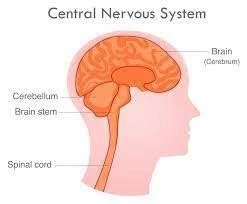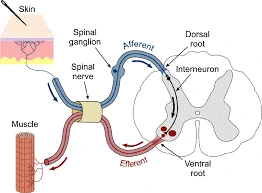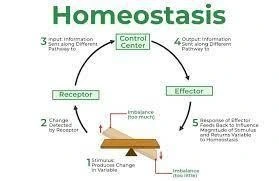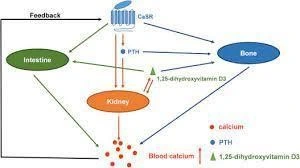+44 75754 30035 help@rapidassignmenthelp.co.uk
offer
🎁Special Offer 🎁 Discounts - Up to 55% OFF!
🎁Special Offer 🎁 Discounts - Up to 55% OFF!
Get expert Assignment Help Online on topics like the endocrine, nervous, and excretory systems—perfect for biology, anatomy, or health science assignments.
The brain, situated at the core of this system, acts as the conductor that collects information from the external environment via sensory receptors such as the eyes, hearing, and skin. These receptors function as the microphones of the symphony, detecting stimuli like light, sound, and touch and transforming them into electrical impulses. Subsequently, these signals propagate through sensory nerves, which function as the communication infrastructure of the orchestra, until they reach the brain, where they are deciphered and examined by specialised regions. After undergoing processing, the brain, acting as a proficient conductor, determines the suitable response (Leisman and Koch, 2023). The reaction is conveyed by electrical signals transmitted via motor neurons, which act as the control wires of the orchestra, and ultimately reach particular muscles or glands. These muscles then contract or relax, resulting in actions such as playing a violin or blowing a trumpet, while glands secrete hormones that affect different biological processes, such as altering the speed of music. Nevertheless, the nervous system not only responds to stimuli, but also serves a vital function in preserving internal homeostasis, like to the tuner of an orchestra. The device continuously monitors essential indicators such as heart rate and temperature, ensuring that these parameters stay within a normal range. In the event of any deviations, the nervous system transmits corrective impulses to reinstate equilibrium, like to a conductor fine-tuning the pitch of a musical instrument. In addition to immediate responses, the nervous system also regulates intricate reflexes, which are involuntary and rapid actions that take place without conscious deliberation (Luecke, 2023). Reflexes such as the knee-jerk or withdrawing a hand from a hot item serve as the pre-programmed reactions of the symphony, guaranteeing individuals instant protection. But the nervous system's capabilities extend far beyond mere physical control. The brain also regulates the domain of cognitive processes such as thinking, memory, acquisition of knowledge, and emotional experiences. Distinct brain areas serve as the musical score for the orchestra, responsible for the storage and retrieval of memories, the formation of thoughts, and the generation of moods (Ghanai, 2023). These abilities let people see the world, resolve issues, make choices, and engage with people in a significant manner.
The Central Nervous System serves as the primary regulatory hub of the human body. The brain processes sensory information, sends muscle-regulatory impulses, and coordinates all body operations.The CNS is essential to life. It allows people to move, feel, and engage with the surroundings. Damage to the CNS can induce paralysis, sensory loss, and cognitive impairment (Alcántar-Garibay et al., 2022). Two main components make up the CNS:
Human brains are the most complex organs. Cognition, remembering, emotion, and sensory experiences are brain functions. Trillions of neurons and synapses make up brains. Neural connections aid cognitive processing and response creation. There are three main brain parts. Multiple cognitive processes are performed by the brain's largest component, the cerebrum (Salehinejad et al., 2021). Brains control thinking, memory, language, and problem-solving. Brains have posterior cerebellums. It controls movement and balance. Brainstems are inferior. Respiration, heart rhythm, and digestion are controlled by the autonomic nervous system. The brain requires 20% of the body's oxygen and energy while being just 2% of its weight. Brains can generate 25 watts, enough to light a lamp.
A long, narrow bundle of nerves, the spinal cord runs along the back of the body. In response to brain impulses, the nervous system governs muscle function. The spinal cord is a long, thin neuronal bundle in the back. Spinal bones protect it. The spinal cord transmits neural information to and from the brain and controls motor processes (Civas and Akan, 2020). Automatic responses to stimuli are controlled by the spinal cord. The length of the spinal cord measures around 18 inches. The spinal cord comprises around 31 pairs of nerves.
Struggling with complex topics like the nervous or endocrine systems? Get accurate and timely Biology Assignment Help tailored to your academic needs.
The brain, the spinal cord, neurons, and connections make up the nervous system. It sends and receives messages, processes information, and manages body activities. Neurons are the building blocks of the nerve system. Signals are sent by specialised cells. Neurons can send and receive messages differently depending on how they are shaped and connected to each other. Neurons can get information from many places thanks to dendritic branches, and different chemicals control how signals are sent at synapses. When you think about and act on knowledge, the mind and spinal cord work together. These things are possible because the brain is very complex and has parts for moving, feeling, and thinking. The peripheral nervous system helps the brain, muscles, and nerves talk to the central nervous system. Organisation of neurons and ganglia makes sensory and movement information easier. In order to function, the nerve system needs to be able to bend and stretch. It includes changes to the structure, like adding or removing links between neurons, and changes to the function, like making more or fewer connections between synapses.

Figure 1: Structure of The Central Nervous System
The Functions of the CNS
The central nervous system controls several functions:
Senses include sight, sound, touch, smell, and taste feed the CNS.
The central nervous system sends muscular signals to move humans.
The CNS integrates sensory input and produces appropriate responses (Smith, 2019).
The CNS regulates heart rate, blood pressure, and temperature.
Through the PNS, the brain, spinal cord, and body send and receive information. Motor instructions that regulate muscle movement and sensory information like touch, pain, and temperature are sent throughout the body by the neurological system (Akinrodoye and Lui, 2020). The courier service that keeps the body running smoothly. Peripheral nervous system has 43 million neurons. The sciatic nerve, from lumbar to lower extremities, is humans' longest nerve. Sensory loss, muscle weakness, and organ malfunction can result from peripheral nerve system impairment. The PNS has two main parts:
Brains communicate with eyes, ears, nose, tongue, and face muscles via 12 pairs of cranial nerves. Eyes, ears, taste, smell, facial expressions, and swallowing are controlled.
Get assistance from our PROFESSIONAL ASSIGNMENT WRITERS to receive 100% assured AI-free and high-quality documents on time, ensuring an A+ grade in all subjects.
The spinal cord produces 31 pairs of nerves that link the limbs, organs, and skin (Kaiser and Lugo-Pico, 2019). Sensory input goes to the brain and spinal cord, while motor instructions control movement in muscles.
The peripheral nerve system has two functional categories:
Somatic nerve system controls conscious voluntary movements. Using brain and spinal cord impulses, the neurological system controls skeletal muscles to move the arms and legs.
An autonomic nerve system controls physiological processes that don't require conscious thought. The autonomic nerve system regulates heart rate, breathing, digestion, vascular tone, and temperature. The Autonomic Nervous System has two branches. The sympathetic nerve system triggers the "fight-or-flight" reaction to handle stress (Derakhshan et al., 2019). Breathing, heart rate, arterial pressure, and glucose rise. The parasympathetic nervous system produces stress-related "rest-and-digest". It lowers glucose, BP, respiration, and heart rate.
The Functions of the PNS
Movement is facilitated by the transmission of coordinated signals through the somatic nervous system, allowing for the activation of our muscles.
Touch, pain, temperature, and location are perceived by sense receptors and nerves.
Heart rate, blood pressure, and digestion are controlled by the autonomic nervous system to maintain homeostasis (Jänig, 2022).
Reflexes provide rapid and automatic reactions to external stimuli, safeguarding us from danger and preserving equilibrium.
When the finger makes contact with a hot object, an extremely rapid reflux immediately pulls it back before one even consciously perceives the discomfort. The spinal reflex arc, a unique response, exemplifies the extensive communication network present in the nervous system.

Figure 2: Schematic representation of a spinal reflex arc
The Pathway
Nociceptors, which are specialised sensory neurons, are the first responders on this journey, which starts at the fingertips. When these receptors pick up on heat, they transform it into an electrical signal.
The axon, a long and thin nerve fibre, carries the electrical signal from a sensory neuron to the spinal cord.
Dorsal Root Ganglion is a group of cell bodies situated just outside the spinal cord where the sensory neuron travels to (Haberberger et al., 2019).
Dorsal root, a vestibular nerve fibre bundle, sends ganglion impulses to the spinal cord.
Ventral horn sensory neurons synapse with spinal cord motor neurons. Synapses link neurons to send messages.
The motor neuron sends an electrical impulse up its axon after receiving the signal.
The ventral root, also called the anterior root, is a group of motor nerve fibres that allow axons from motor neurons to leave the spinal cord (Akinrodoye and Lui, 2020).
The axon of the motor neuron eventually reaches the effector organ, which is the muscle in the finger. In this step, an electrical signal contracts the muscle fibres, releasing the finger from the heated object.
The Mechanism of Transmission
Action potentials, which are quick changes in electrical potential across the neuronal membrane, carry the nerve impulses throughout this process. Membrane ion channels are opened and closed to form an electrical current, which in turn generates these action potentials by enabling charged ions, such as potassium and sodium, to pass across.
An Example of Reflex Variability
Where the stimulus is and how bad the pain is can affect the exact direction and velocity of the spinal reflex arc. There may be one synapse involved when one removes their hand from something that's only slightly heated, but there might be many and a quicker reaction time in the case of a severe burn.
The Importance of the Spinal Reflex Arc
Protecting people from danger and keeping homeostasis in check, spinal reflexes are crucial to human’s existence (Crosson et al., 2019). They show how the nervous system is very efficient and complicated, allowing people to safely and dynamically interact with our surroundings.
The Speed Advantage
Overlooking the brain's delayed processing time, the entire process happens in milliseconds. By responding swiftly to stimuli that could cause harm, humans are able to prevent more harm.
Every body system is interconnected and works together to keep individuals alive and healthy. A complicated dance is performed by the nervous and endocrine systems. Their methods differ, yet they both aim to achieve the same goal.
Communication Channels
Rapid electrical impulses carried via nerves are the backbone of the neurological system. These impulses are transmitted straight from the neurons to the muscles and organs that need to be acted upon right away.Imagine a network of millisecond-fast wires transmitting data. The endocrine system communicates with hormones. Specialised glands release these hormones into the circulation, where they can reach a larger variety of cells (Al-Suhaimi et al., 2022). Imagine a more extensive and slower postal service that delivers messages over the course of minutes or even hours.
Target Specificity
There is a great deal of target specificity in the nervous system. The ability to precisely control isolated functions is made possible by connecting individual neurons to specific muscle fibres or organs (Wang et al., 2019). Basically, it's the same as sending an individualised email. The opposite is true for hormones, which are often less precise. They attach to receptors on different kinds of cells as they travel through the bloodstream. This makes the impact bigger and lasts longer, but the message is less targeted. It is the equivalent of an organization-wide email blast.
Speed of Response
In order to respond instantly to stimuli, the nervous system, as previously said, transmits signals at tremendous rates. Quick reflexes, coordinated movement, and the ability to respond to danger quickly all depend on this. It is quite similar to instant messaging in that it allows for control and changes in real time. Time is of the essence for the endocrine system. Production, secretion, and circulation of hormones all require time before they reach their destinations. Although slower speeds provide longer-lasting impacts, they may not be ideal for situations requiring fast reflexes. It works like mailing a letter, but slowly.
The body's ability to maintain internal conditions regardless of external stimuli is called "homeostasis". It seems like the body is always maintaining internal balance. Physiological systems control temperature, pH, blood sugar, and others within a restricted range, allowing the body to function (Libretti and Puckett, 2020). If activity or external heat raises body temperature, sweating and increased blood flow to the skin help cool it down. Shivering and vasoconstriction keep the body warm in cold weather.

Figure 3: Homeostasis
Chemical feedback mechanisms are crucial for the maintenance of homeostasis. These systems entail the secretion of hormones or other substances that interact with specific receptors to control a certain function. Chemical feedback systems may be classified into two primary categories:
Negative feedback is the predominant form of feedback system that plays a crucial role in sustaining stability. Negative feedback involves the effector's response that opposes the initial stimulus, therefore restoring the system to its fixed point (Jiang and Hao, 2021). After blood sugar rises, the pancreas releases insulin to help cells absorb glucose, lowering blood sugar.
Positive feedback: This feedback amplifies the stimuli, increasing reaction. Positive feedback is rare yet necessary for childbirth and blood coagulation. During labour, oxytocin and oestrogen establish positive feedback loops that increase contractions and lead to birth.
As mentioned, the pancreas releases insulin when blood sugar rises. Insulin helps cells absorb glucose, lowering blood sugar. This negative feedback loop keeps cells energised and limits blood sugar spikes. Thyroid hormones control metabolism. The pituitary gland releases thyroid-stimulating hormone when metabolic rate is low, increasing thyroid hormone production (Babić Leko et al., 2021). This negative feedback loop maintains a balanced metabolic rate, which generates energy and regulates weight. The adrenal glands release adrenaline under stress. Epinephrine raises heart rate, respiration, and blood pressure for fight-or-flight. After removing the stressor, the body releases cortisol to normalise. Negative feedback loops manage stress and reduce long-term physiological damage.
Physical activities include muscle contraction, neuron transmission, and bone health requires calcium. Endocrine system, including parathyroid and thyroid glands, regulate blood calcium levels.
Parathyroid Hormone
Function: Neck parathyroid glands release parathyroid hormone when blood calcium dips too low.
Action: Parathyroid hormone releases calcium from bones into circulation (Lofrese et al., 2022). Additionally, it acts on the kidneys to reduce calcium loss in urine and improve intestinal calcium absorption. Blood calcium levels are increased by these processes.
Calcitonin
Source: The thyroid gland produces this.
Function: Calcitonin secretion is triggered by elevated blood calcium levels.
Action: By preventing bone tissue degradation, calcitonin lowers blood calcium levels. As an added bonus, it reduces blood calcium levels while increasing bone calcium deposition.

Figure 4: The regulation of calcium homeostasis
Importance
Parathyroid hormone and calcitonin stabilise calcium levels (Lofrese et al., 2022). By redistributing calcium from bones and storing it inside, parathyroid hormone raises calcium levels when they fall. In contrast, calcitonin aids in lowering elevated calcium levels by increasing bone calcium storage and decreasing blood calcium release. Functioning muscles, transmitting nerve signals, clotting blood, and strong bones all depend on this balance. Calcium levels too high or low for a long time might cause weak muscles, bone anomalies, nerve dysfunction, and others. The body uses blood calcium to its greatest capability within a narrow range, and the endocrine system is essential.
The kidneys are a pair of diminutive, kidney-shaped organs situated in close proximity to the lumbar region, serving a crucial purpose in upholding regular bodily processes. They carry out a diverse range of crucial duties, which encompass:
Waste Removal
The kidneys filter blood and remove waste and excess fluid. They filter 200 quarts of blood daily for urea, creatinine, and uric acid. The body excretes urine made from these byproducts and water.
Maintaining Electrolyte Balance
Electrolytes help electrical conduction in the circulation and are needed for nerve signal transmission, muscle contraction, and heartbeat (Zhao et al., 2022). The kidneys regulate electrolytes including sodium, potassium, calcium, and magnesium to ensure homeostasis and optimal physiological function.
Blood Pressure Regulation
The kidneys regulate blood pressure by managing fluid and salt retention. Renin and erythropoietin regulate blood volume and red blood cell production, affecting blood pressure.
Acid-Base Balance
According to Zamora-García and Muñoz (2022), the kidneys regulate the body's acid-base balance by excreting excess acid in urine. Enzymes and other biological activities require appropriate pH.
Hormone Production
The kidneys produce renin, erythropoietin, and calcitriol. These hormones regulate blood pressure, erythropoiesis, and skeletal integrity.
Blood Volume Regulation
The kidneys regulate water excretion to maintain blood volume. This process is necessary for appropriate blood pressure and circulation.
Red Blood Cell Production
Erythropoietin from the kidneys increases bone marrow red blood cell synthesis. For tissues and cells to have enough oxygen, erythrocytes are needed.
Vitamin D Activation
Vitamin D becomes calcitriol in the kidneys. Calcitriol is essential for intestinal calcium absorption and bone and tooth health.
Drug Excretion
Drug and chemical filtration is one of the kidneys' main functions (Makhdoumi et al., 2020). These molecules are excreted in urine by the kidneys, cleansing the body and avoiding toxicity.
Metabolic Processes
Gluconeogenesis and glucose catabolism for energy are kidney metabolic processes.
By performing several crucial functions, the kidneys maintain normal biological processes. Waste disposal, electrolyte management, blood pressure regulation, acid-base balance, hormone synthesis, blood volume control, red blood cell creation, vitamin D activation, medication excretion, and metabolic mechanisms depend on the kidneys.
Renal Cortex and Renal Medulla
The outermost renal cortex filters most kidney fluid. Renal pyramids help concentrate urine in the renal medulla.
Nephrons
Nephrons are the minuscule, operative components of the kidney that carry out the tasks of blood filtration and urine production.
Every nephron is comprised of a renal corpuscle, which includes Bowman's capsule and glomerulus, as well as a renal tubule, which comprises of the proximal convoluted tubule, loop of Henle, distal convoluted tubule, and collecting duct (Caon and Caon, 2020).
Blood is initially received by the nephron via the glomerulus, where tiny molecules, waste products, and surplus substances are separated and transferred into Bowman's capsule. These compounds are further processed through the tubules.
Reabsorption and secretion are vital processes in which crucial substances such as water, glucose, and electrolytes are transported from the tubules back into the bloodstream, while waste products and surplus substances are eliminated through the tubules to create urine.
Renal Blood Supply
The kidneys are supplied with a significant volume of blood via the renal artery. Following the process of filtering, decontaminated blood is discharged through the renal vein. The peritubular capillaries and vasa recta are blood vessels that encircle the nephrons and assist in the process of reabsorption and secretion of chemicals.
Renal Pelvis and Ureter
Nephrons empty their contents into the kidney's central funnel-shaped renal pelvis (Fox, 2023). The ureter is a muscular tube that carries urine from the renal pelvis to the urinary bladder, where it is stored until it is time for elimination.
Relation to Function
The nephrons' architecture makes it easy for blood to be filtered, separating necessary molecules from waste and excess chemicals. Effective reabsorption of essential compounds into the circulation is made possible by the increased surface area caused by the highly folded nature of the tubules. The collecting ducts, medulla, and nephrons help concentrate urine by reabsorbing water from filtrate (Abdalla, 2020). A large network of blood arteries ensures blood flow for kidney filtration and reabsorption.
The kidney's unique architecture allows each component to execute a specific function (Vorobev et al., 2021). This balance of filtration, reabsorption, secretion, and concentration removes waste and keeps the interior clean. Studying the human body's extraordinary structure and functions may help one appreciate its complexity and magnificence.
The kidneys clean the blood of waste and chemicals, which is why they make urine. Their highly specialised structure makes this process work better. In the kidneys, small nephrons filter blood and make pee. The glomerulus and renal tube of the nephron help the blood take in water, glucose, and ions again, and the urine gets rid of waste and extra substances. Through the ureters, the kidneys send pee to the bladder to be stored. The smooth muscle and mucous layer in their bodies allow peristaltic movements to move urine from the kidneys to the bladder. Ureteral valves stop pee from going backwards. The muscle urinary bladder holds urine until it is passed. The bladder can stretch and contract to let pee out through the urethra because it is made up of smooth muscles and stretchy tissue. These tubes let urine leave the body. Even though men and women are built differently, they both go to the toilet outside. When men ejaculate, semen is moved through the urethra. Balance of body fluids and electrolytes depends on the system that gets rid of waste. The kidneys specifically take in or get rid of water, sodium, potassium, and chloride ions to keep the body's environment in check. This change affects blood pressure, chemical balance, and how much water is in the body.
References
Introduction – MG629 Developing Strategic Management And Leadership Skills Assignment Successful leadership within...View and Download
Introduction Turn every challenge into an opportunity with Rapid Assignment Help’s exceptional Assignment Help...View and Download
Introduction: A Guide to Effective HR Policies Get free samples written by our Top-Notch subject experts for...View and Download
Chapter 1: Introduction of Ethical Considerations In Women’s Participation In Clinical Trials 1.1. Introduction The study...View and Download
Introduction Get free samples written by our Top-Notch subject experts for taking online Assignment...View and Download
Introduction to Career Viewpoint Assignment The report is based on the self-evaluation of experiences, knowledge, and skills...View and Download
